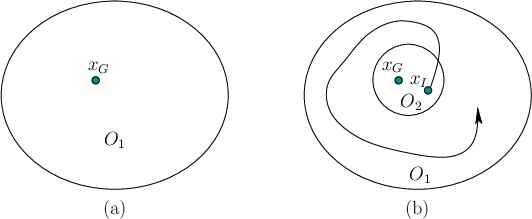
Next: Asymptotic stability Up: 15.1.1 Stability Previous: 15.1.1 Stability
At the very least, it seems that the state should remain fixed at
![]() , if it is reached. A point
, if it is reached. A point
![]() is called an equilibrium point (or fixed
point) of the vector field
is called an equilibrium point (or fixed
point) of the vector field ![]() if and only if
if and only if
![]() . This does not, however, characterize
how trajectories behave in the vicinity of
. This does not, however, characterize
how trajectories behave in the vicinity of ![]() . Let
. Let
![]() denote some initial state, and let
denote some initial state, and let ![]() refer to the state
obtained at time
refer to the state
obtained at time ![]() after integrating the vector field
after integrating the vector field ![]() from
from
![]() .
.
 |
See Figure 15.1. An equilibrium point
![]() is
called Lyapunov stable if for any open
neighborhood15.1
is
called Lyapunov stable if for any open
neighborhood15.1 ![]() of
of ![]() there exists
another open neighborhood
there exists
another open neighborhood ![]() of
of ![]() such that
such that
![]() implies that
implies that
![]() for all
for all ![]() . If
. If
![]() , then
some intuition can be obtained by using an equivalent definition that
is expressed in terms of the Euclidean metric. An equilibrium point
, then
some intuition can be obtained by using an equivalent definition that
is expressed in terms of the Euclidean metric. An equilibrium point
![]() is called Lyapunov stable if, for any
is called Lyapunov stable if, for any ![]() , there exists some
, there exists some
![]() such that
such that
![]() implies that
implies that
![]() . This means that
we can choose a ball around
. This means that
we can choose a ball around ![]() with a radius as small as
desired, and all future states will be trapped within this ball, as
long as they start within a potentially smaller ball of radius
with a radius as small as
desired, and all future states will be trapped within this ball, as
long as they start within a potentially smaller ball of radius
![]() . If a single
. If a single ![]() can be chosen independently of every
can be chosen independently of every
![]() and
and ![]() , then the equilibrium point is called uniform Lyapunov
stable.
, then the equilibrium point is called uniform Lyapunov
stable.
Steven M LaValle 2020-08-14